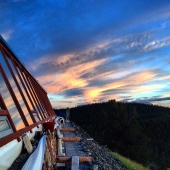There is a serious problem here: For a battery to work (and this is decidedly a battery), you must be able to "intercept" the free electrons in the chemical reaction in order to get current flow. Yes, there are definitely electrons moving about in a hydrocarbon reaction, but those electrons are moving from the water molecules to the hydrocarbon molecules as they are formed. Stabbing an "anode" and a "cathode" in the ground will do nothing to capture these electrons, and I would be willing to bet that any demonstration pieces that exist will be using either iron and zinc or copper and iron electrodes to create ACTUAL electron flow by means of a galvanic reaction of the electrodes themselves (this is, after all, how a battery works), in order to trick investors.
In this diagram, basically the "plant matter" is just the electrolyte from which the electrons pass from the anode to the cathode.
If you actually wanted to intercept the electrons from the hydrocarbon reaction, you would need an anode made of water, another anode of oxygen, and a cathode of hydrocarbon. Of course this cannot be done, and even on a very, very large scale, there is never a electrical potential developed in plants, otherwise trees would shock you.
That said, there is nothing that says you cannot use the waste heat from this reaction to power a thermoelectric generator. It would be horribly inefficient, though.




